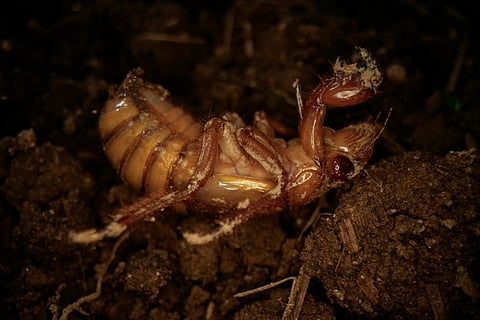Prepare to witness one of nature's most thrilling spectacles as trillions of periodical cicadas emerge from their subterranean slumber, ready to embark on a journey that defies time itself. These remarkable insects, with their crimson eyes and aerodynamic physiques, are about to grace the landscape with a symphony of sound and a display of evolutionary prowess that will leave observers in awe.
Epic Outburst Of Periodical Cicada-Geddon Is On Way, Biggest Bug Emergence In Centuries
Periodical cicadas, a fascinating species of insects, emerge from their underground slumber every 13 or 17 years, akin to a meticulously choreographed ballet.
A Dance of Time and Nature
Every 13 or 17 years, like clockwork, periodical cicadas emerge from the depths of the earth, their synchronized emergence akin to a meticulously choreographed ballet. Unlike their yearly counterparts, these ebony-winged creatures remain hidden beneath the soil until the opportune moment arrives, signaling their ascent with a crescendo of chirps that reverberate through the air like the roar of a distant thunderstorm.

A Convergence of Cicadas
This year holds a special surprise as two distinct cicada broods converge in a spectacular display of nature's ingenuity. Brood XIX, emerging every 13 years, will blanket the Southeast with their presence, while Brood XIII, emerging every 17 years, will cast its spell over the plains of Illinois. It's a convergence of epic proportions, a veritable cicada-geddon that hasn't been witnessed in over two centuries.
The Impact and Intricacies
As these winged wanderers emerge, they bring with them a flurry of activity and a hint of mischief. While their arrival may spell trouble for tender saplings and delicate crops, it's also a boon for wildlife and ecosystem health. These buzzing beauties play a vital role in the intricate web of life, serving as a feast for hungry predators and contributing to the cycle of renewal that sustains our natural world.

An Evolutionary Enigma
What drives these enigmatic insects to emerge in such perfect synchrony? It's a question that has puzzled scientists for centuries. Some speculate that their prime-numbered emergence cycles are nature's way of outsmarting would-be predators, while others marvel at the genetic diversity and adaptability that allow them to thrive in a world of constant change.
The Symphony of Cicadas
As the cicadas take center stage in their annual mating ritual, the landscape comes alive with a cacophony of sound that rivals even the most raucous of symphonies. The males, with their vibrant calls and intricate courtship displays, vie for the attention of their potential mates, creating a mesmerizing spectacle that captivates all who bear witness.

